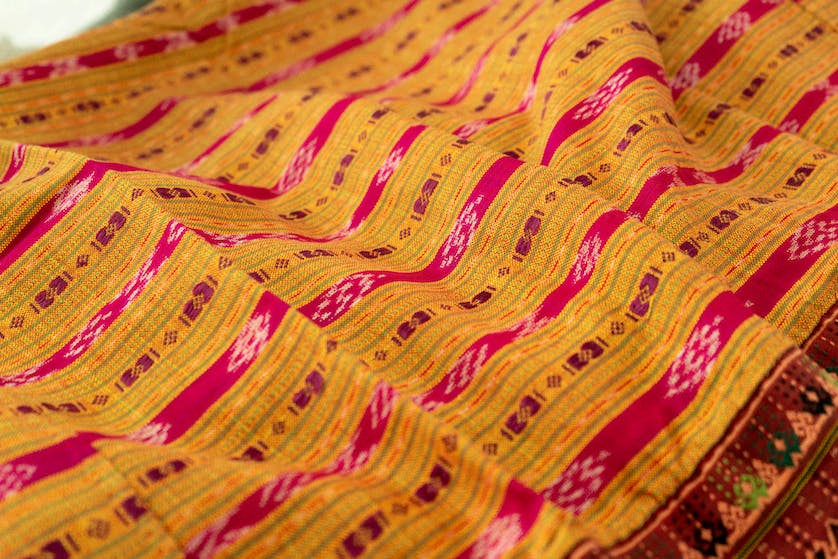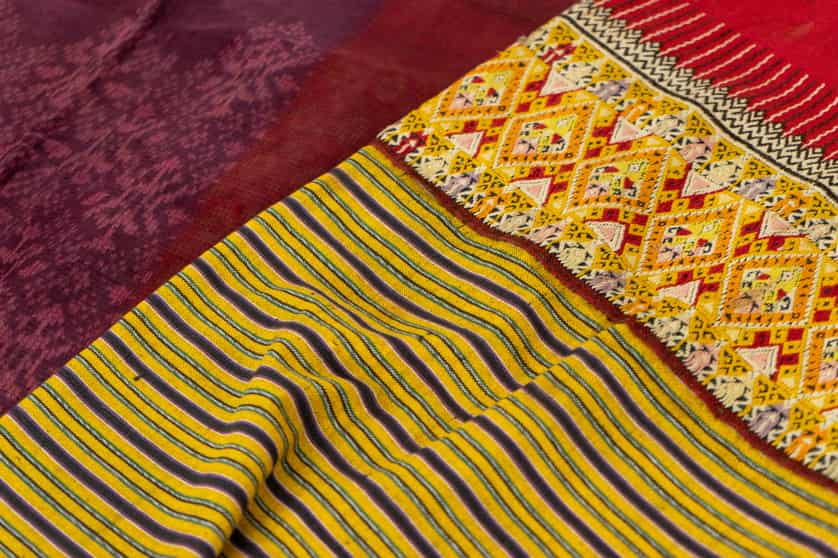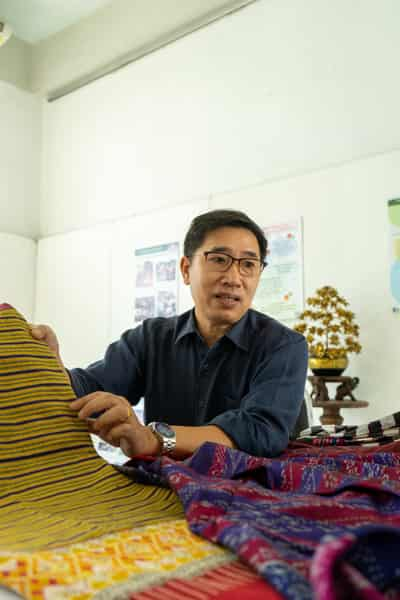“Clothes are the most intimate items for people,” said Wasin a (Aunchanum), costume designer of the mega budget and hit TV drama Raknakara, in a lilting Lanna accent. “It is more than a wearable apparel because it reflects our mindset, our economy, our lifestyle and our values.”
While many cold countries wear numerous layers of clothing to ward off the weather, in our part of the world, south of the Himalayas, historically our main apparels have been for the lower half of the body only. “In the old days tops were almost unnecessary for the kind of weather we were living in,” said Asst. Prof. Thianchai Aksrondit, Faculty of Fine Arts, Chiang Mai University, as he explained to us the history of Lanna’s fashion ware. “As in many cultures, men and women wear different clothes; men wore simple plain or checked patterned materials wrapped around the waste longi style, and women wore tube-shaped skirts, called sinh, typically woven in far greater detail.”
“Lanna women were the weavers and crafters of the garments, unlike India and some other countries where the men were tasked with the weaving,” continued Thianchai. “Because Lanna men often travelled with caravans for trade, they were quicker to adapt to and adopt from foreign cultures. For instance look at the old habit of tattooing. Men would have tattoo designs from a great number neighbouring lands in a variety of styles. On the other hand, women were tied to the home and played the important role of inheriting and passing on the family legacy.”
“As the bearer of the family name and local traditions, it was the women who would weave their values and beliefs into their textiles, passing it on from mother to daughter to granddaughter,” added Wasin, explaining how distinctive patterns, techniques and style came to represent certain communities and cultures.
Akadet Nakkabunlung, owner of Sbun-Nga Textile Museum explained that the skills of a woman in creating the most detailed, beautiful and neat textile, was of great importance. “She would spend months and months weaving her sinh, adding a swan here and a bird there, trying her best to make the design as detailed and precise as possible. These were never for sale because there was no market for such things then as women always made their own. She would then wear it to an important temple fair and hope to catch the eye of a good man. The men would look at a woman’s sinh and if it was sloppy or ugly, would eschew her for a wife as she would be seen as lazy and messy. A woman with an elegant and refined sinh would be coveted for a wife.”

Weaving the Past
Chiang Mai’s weather was too humid to be suitable for breeding silk worms; our fabric of choice and expertise was therefore always cotton. Textile experts believe that the distinctive and famous traditional Chiang Mai techniques and patterns, famously, Mae Chaem District’s sinh teen jok, are believed to have originated from the Tai Yuan people living in Chiang Saen. During the late 18th century when Chiang Mai was repopulated by a variety of people including the Tai Yaun from Chiang Saen, who brought their skills with them. In fact, during that time, the technique spread far and wide, even reaching as far south as Ratchaburi Province, where antique textiles from that era have been found to bear striking resemblance to Chiang Mai’s teen jok.”

As Chiang Mai folded itself into Siam, rebuilding over the course of the following century, its royal classes came into close contact with Bangkok’s elite and a new sophisticated weaving technique began to be worn by the upper echelons of society. Jok viang Chiang Mai, is a textile which evolved during the Chet Ton Dynasty (1732-1932) and which used newer materials not native to the area. This royal Lanna textile used premium quality cotton imported from England and France and premium silk imported from China and India. These expensive garments are today highly coveted by collectors, though many local experts bemoan their loss to private collections around the world.
“Some Chiang Mai collectors have been trying to buy them back,” said Akadet, whose museum owns two rare jok viang Chiang Mai pieces. “One collector even went to an auction house in London to purchase one to bring home. They can cost around a million baht a piece today.”

Jok is a technique that requires weavers to embroider on the looms while weaving. Colours matter, therefore threads have to be dyed and precisely positioned on the fabric. Jok viang Chiang Mai worn by elites on the other hand, added value with the entire body of sinh being crafted from silver and gold threads. “While sinh jok vieng Chiang Mai had the sparkles of the imported golden and silver threads, the rural areas such as San Pa Tong also evolved and began adding some expensive materials and threads, though to a far lesser degree, today known as sinh San Pa Tong. Southern areas, further from markets and trade, such as Chom Thong and Mae Jaem stuck with cotton,” explained Thianchai.

Much credit is given to Her Highness Princess Chao Dara Rasmi, the royal consort to King Rama V who hailed from Chiang Mai. In spite of numerous years in the Bangkok courts, she is renowned for her Lanna identity — introducing northern dishes to the royal kitchens and always wearing her traditional Lanna sinh, free of glitter and gold.
“For people of that time, clothes were a representation of their heritage and roots,” said Wasin. “Similar to the structure of sinh, where there is ‘hua’ or head, ‘tua’ or body and ‘teen’ or foot, society also has the three layers, starting from the elite, commoners and proletarian. It reminded people that there were roles in society and that one could not just wear or do whatever one wanted.”
Preserving the Future
“As Mae Jaem is an isolated area, their cultural heritage is better preserved than in other parts,” said Thianchai. “Crafting sinh is a delicate procedure. It’s not just about weaving but it is a total process from growing the cotton and dye plants to imagining patterns. As people take short cuts and begin to purchase elements for creating a textile, their costs begin to add up. When the costs become prohibitive, people seek cheaper solutions and substitute cotton with nylon or chemical dye. This devalues the entire process and product.”
Sinh Lanna is seeing a revival in appreciation of late, thanks to academic research and support from the private as well as government sectors. Twenty years ago the average price for a piece of sinh teen jok from Mae Chaem was only around 300 baht, whereas today buyers will have to consider spending four to five figures on an average piece. “Sinh Chiang Mai is well known across the market. It’s a sellable brand which everyone recognises,” said Wasin who owns a traditional costume shop selling mainly Lanna textiles. “Interestingly enough, the majority of the customers are from Bangkok, who are either visiting here or go back and forth between the two cities.” His has noticed that Chiang Mai people have less appreciation for local craftwork than outsiders. “They are not quite willing to pay. They don’t mind wearing a simple plain cotton sinh to the temple. It’s the mindset of the people, notice that we barely have the patience to wait in a queue for a popular restaurant,” stated Wasin. He also noted that Bangkok is a hub for middle class people who have moved into the city for work, and with the current trend of the world, they crave connections to their places of origin. “It’s kind of like they are nostalgic about the past and want to express that they have roots — not just somebody existing in the world,” said Wasin. While people in the past spent days and months crafting a garment to wear, modern people are happy to spend large amounts of money, yet not time, to fulfil their craving to connect to their roots, in an effort to express an identity to the world.
This December from 8th to 16th, in conjunction with Chiang Mai Design Week, Chiang Mai City of Crafts and Folk Art will be holding the Craft Fair 2018 exploring and sharing their deep knowledge on Lanna textiles along with other cultural heritage. There will talks, workshops, exhibition and many more inspiring activities during the event. Participant will get a chance to meet with experts and craftpoeple to learn and experience first hand from their skill and knowledge. For more information please visit Facebook: Chiang Mai City of Crafts and Folk Art


